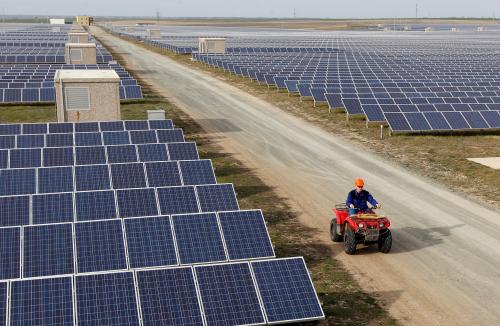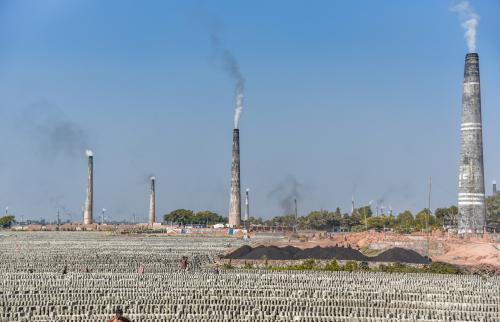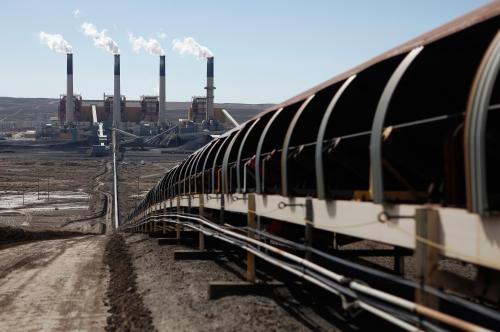Most experts believe that it will be expensive and challenging to shift from today’s energy system, which is largely based on fossil fuels with their associated greenhouse gas emissions, to a new zero-carbon energy system. The size of this challenge is why changes in government policy have been slow to develop, while greenhouse gas emissions continue apace.
But a vocal and growing number of analysts believe that decarbonizing the energy system will be surprisingly easy and free. Many believers in cheap decarbonization focus on the promise of renewable energy, despite the fact that there are many ways to cut emissions. We have the technology now to move to a carbon-free economy, so they say, if only vested political interests from fossil fuel companies would get out of the way.
In a pathbreaking new article released today in the Proceedings of the National Academy of Sciences, a number of scientists—including David Victor, the co-director of the Cross-Brookings Initiative on Energy and Climate—aim to put this idea to rest.
The article is a rebuttal to an attention-grabbing paper, written by Mark Jacobson of Stanford University and several co-authors, which claims that all U.S. energy end uses (including electricity, transportation, heating/cooling, and industry) can be supplied using only wind, solar, and water power by 2050-2055 at lower cost than using fossil fuels. Jacobson et al specifically exclude other zero-carbon sources of energy, including nuclear, bioenergy, and combustion of fossil or biofuels with carbon capture and storage (CCS).
The notion that a zero-carbon future is close at hand and inexpensive is certainly appealing. Climate change is one of the great challenges of our time, with its origins at the very heart of the modern economy and its worst effects global, uncertain, and delayed. But as David Victor and the other authors demonstrate, moving to a zero-carbon system so quickly isn’t easy. The point of the rebuttal paper is not to say that a low-carbon future is an impossible or pointless goal. Rather, the authors stress that overly optimistic analyses and assumptions can get in the way of true progress toward decarbonizing the energy system and can decrease the world’s motivation to develop new and innovative technologies.
About those assumptions…
Meeting all U.S. energy needs using only wind, solar, and water energy requires some heroic assumptions, in the electricity sector and in other energy-consuming applications. These leaps of faith underlie the analysis of Jacobson et al and bring all of their paper’s conclusions into question. The most important and challenging assumptions lie in balancing the electric grid and in establishing a hydrogen economy.
Electricity is pivotal. In the electricity grid, supply and demand must be in balance at all times. Given the intermittent and non-dispatchable nature of wind and solar power, aligning supply and demand in the system relying only on wind, solar, and water power is a huge challenge. But this is a key place where the Jacobson et al analysis drifts into fantasy. In their analysis, Jacobson et al use three main tools to bring the grid into balance—very large amounts of energy storage, a nationally integrated electric grid, and vast amounts of load shifting to times when more power is available.
Inexpensive, efficient storage of non-fossil energy is the holy grail of energy research, and would truly be a game-changer for effectively integrating intermittent renewable sources into the grid. However, no storage system is currently available at nearly the scale that Jacobson et al envisages—with capacity more than twice the entire capacity of all power plants in the United States today. Their analysis assumes growth in hydroelectric pumped storage, vast amounts of underground thermal storage, and storage in phase change materials at concentrated solar plants. Jacobson et al assume a massive change in how existing hydroelectric dam infrastructure can be ramped up and down to store energy and produce electricity on demand, even though physical and environmental limits will make this all but impossible. Underground thermal storage is not yet demonstrated at scale, but the analysis assumes that underground thermal storage will be deployed in nearly every home, business, office building, hospital, school, and factory in the United States by 2050. Phase change materials for energy storage are still at the research and demonstration phase, but play an important role in the analysis.
Assumptions about shaping electricity demand to meet variable supply are also challenging. Jacobsen et al assume nearly 2,000 gigawatts of load shifting, but do not calculate the costs related to shifting demand over time. In this world of time-flexible demand, excess production capacity would be needed in industries that operate only when power is available, compared to the capacity needed if they operated consistently. This would certainly raise capital and production costs, but such costs are not considered in the analysis.
For the parts of the energy system that are difficult to electrify, Jacobson et al assume a shift to hydrogen, with a massive scale-up of hydrogen production and use. Hydrogen is an energy carrier rather than an energy source, more like electricity than oil. Thus, hydrogen must be generated in this system using wind, solar, and water power, at a peak rate that consumes nearly 2,000 gigawatts of electricity, twice the current U.S. electricity generating capacity. Jacobson et al assume that hydrogen powers half of the transportation sector and 11 percent of energy intensive industry. Additionally, the cost and feasibility of transitioning industries to hydrogen are not accounted for. Certain applications that require high heat or high energy density, such as cement, steel, and aviation, are likely to be challenging to adapt to hydrogen.
[P]retending that the solutions are cheap and easy is ultimately not helpful for combating the challenge of climate change.
All of these are practical criticisms of a near-term shift to an energy system entirely reliant on wind, solar, and water. But the deeper level of criticism is about the focus on establishing an energy system that excludes many other sources of low- or zero-carbon energy. Nuclear energy, bioenergy, and fossil fuel sources (particularly with CCS) may have roles to play in future energy systems, and excluding them a priori is likely to increase the cost of achieving climate change goals. Jacobson et al exclude these sources based on a number of unconventional assumptions about their costs and emissions that differ from the scientific consensus, including the work of the Intergovernmental Panel on Climate Change. For example, Jacobson’s earlier work attributes to nuclear power up to 19 years of fossil-based emissions during the construction phase of a reactor and emissions from nuclear weapons use assumed to periodically occur on a 30-year cycle.
Thought experiments about future zero-carbon energy systems are important, to consider how an energy transition can play out and where the biggest challenges in such a transition lie. But one can’t let dogma get in the way—the world’s reaction to climate change must be politically and economically durable enough to last for generations. Unnecessarily limiting technology options or pretending that the solutions are cheap and easy is ultimately not helpful for combating the challenge of climate change.









Commentary
The fantasy of quick and easy renewable energy
June 19, 2017